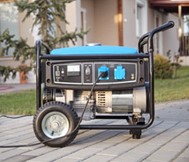Tips on Home Generators
Anyone considering the purchase of a standby generator should be aware of a number of factors before purchasing and installing. For example, standby generators with “open” transfer switches do not need to go through the full Customer-Owned Generation interconnection process. An open transfer switch connects the generator to a home or business’ electrical system, but always disconnects from the OPPD electric system before connecting to the generator. This is very important to ensure the safety and reliability of the electric grid. The full list of requirements for standby generators is shown in chapter 11 of the OPPD Meter Specification Manual. If you are considering the installation of a backup generator, know that OPPD needs to review and approve the transfer switch being used prior to installation. In order to obtain this approval, email the facility address, electrical permit number and the manufacturer and model number of the transfer switch to ProductsandServices@OPPD.com. OPPD will review the information and reply within a few days.
General Information
- Standby generators are designed for home and farm use in a variety of models and sizes.
- Sizes of standby generators range from an output of 1 kilowatt (kw) to over 100 kw.
- Portable gasoline engine generators are designed to provide a reliable source of portable power for a wide variety of applications.
- Engines usually run on gas or diesel, but models are also available for propane or natural gas.
Sizing of Home Generators
- Manufacturers rate each standby generator on how much power (kw to kva) it is capable of supplying. That rating is noted on the generator's nameplate.
- A generator can be purchased with the capability of supplying an entire residence, or a smaller generator can be purchased to supply only a portion of a home's electrical load.
- The total electric load on your generator must not exceed the manufacturer's rating.
- If the generator will supply only a portion of the home's electrical load, a list should made of the electrical equipment to be powered during a utility outage (e.g., appliances, lamps, home furnace blower motor, etc.). Compare the total wattage of the equipment to the total wattage output rating of the generator (if an item is rated in amps, simply multiply the amps by the voltage to determine the wattage). For example, to power ten 100-watt light bulbs, the generator should be rated at least 1,000 watts.
- The generator should be capable of starting the largest motor that is supplied by the generator under emergency conditions. If a group of motors is to be started simultaneously under emergency conditions, the generator must be capable of supplying the required starting current for each motor.
- If it is decided the generator should have the capacity to supply an entire residence, the KW rating of the standby generator should be greater than the maximum full load of the residence.
Installation of a Standby Generator (Portable)
- Portable generators are designed for connection only to smaller selected appliances or lamps. They should never be connected directly to a building's wiring system.
- Carefully read all instructions included with the generator before operating it. Be sure that the total electric load on your generator does not exceed the manufacturer's rating.
- Portable generators should be kept outside during use to ensure the exhaust will vent safely. (Use of a generator in an enclosed area may cause a buildup of carbon monoxide or other harmful exhaust gases.)
- Always wait five minutes or more for the generator to cool down prior to refueling.
- Keep extension cords out of the way or protected so they don't present a tripping hazard.
- Never run electrical cords under rugs or carpets, where damage to a cord may go unnoticed or heat might build up. Make sure cords are properly sized to carry the electric load, as overloaded cords can overheat and cause fires.
Installation of Standby Generators (Permanent)
- Customer's Standby Generation Installations (From OPPD's Meter Specifications Manual.)
- Permanent installation of a larger generator set may require a concrete foundation to support the engine and generator.
- To allow a home generator set to provide power through the house electrical distribution system, a transfer switch must be installed. The transfer switch (also called a throw-over switch) allows the electrical load to be connected to either the generator supply or utility supply, but prevents simultaneous connection. NOTE: Severe consequences will result if a transfer switch is not used when connecting a standby generator. Among other things, simultaneous connection can cause the generator to backfeed onto OPPD's distribution system, resulting in an unsafe condition that could damage equipment or electrocute line crews working on de-energized lines.
- Transfer switches are available in either manual or automatic operation.
- Transfer switches should always be rated to carry the larger of the maximum full load of the residence or the full output of the standby generator.
- Here are a few of the important functions related to transfer switches:
- Prevent connecting the generator to the load until after the load is disconnected from OPPD's system: “break-before-make.”
- Positively prevent accidental connection of the generator to OPPD's system at any time. The general arrangement of the wiring and equipment shall prevent any accidental connection between the normal (OPPD's) supply and the alternate (generator) supply.
- Provide for visible inspection by OPPD of the transfer switch or device position. Mechanically interlocked breakers or other contacts utilized in a manufacturer’s assembly meeting the UL 1008 Transfer Switch standard, with visible means of determining the switch position, are acceptable. Field-engineered interlock solutions are not acceptable. Kirk-key interlocks on manufactured switchgear may be acceptable depending on the key type and other factors.
- Be on the customer's side of the revenue meter.
- Transfer switches and other transfer devices or assemblies must be a manufacturer’s assembly listed by an approved testing agency for use as transfer equipment.
General Safety Rules for the Use of Standby Generators
- All wiring and equipment must comply with local, state and federal laws or codes, and rules and regulations of OPPD.
- All wiring and equipment must have approval of the local inspection authority.
- The standby generator must be rated at 60-hertz alternating current, and the voltage rating must be the same as the service voltage supplied by OPPD.
- Automatic transfer switch systems must be approved by OPPD.
- The general arrangement of the wiring and equipment must prevent any accidental connection between the usual supply and the alternate supply.
- Only a qualified professional, such as a licensed electrical contractor, should install a permanent standby generator.
- Use your standby generator correctly. Carefully read and follow the manufacturer's instructions.
For more information, contact the Electric Service Designer in your area.


